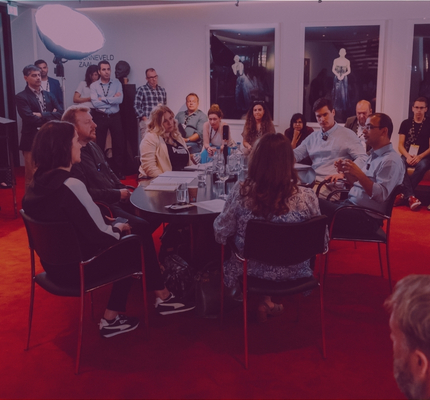
TV
Unveiling the Secrets of Effective Search Design with Vitaly Friedman
In a Discovered London 23' talk, Vitaly Friedman, the co-founder of Smashing Magazine, provided a fascinating look at the thought process behind search, recommendations, and design elements that can make or break a user's experience.

Search functionality is a crucial component of any website or application, and the way it is designed can have a significant impact on user experience. In a recent conference, Vitaly Friedman, co-founder of Smashing Magazine and an experienced consultant in web design and development, shared his insights on crafting effective and engaging search experiences.
Drawing from his extensive work with various organizations, Vitaly emphasized the importance of striking a balance between visibility and simplicity in search design. Throughout his talk, he provided real-world examples to illustrate the impact of design choices on user engagement, accessibility, and overall user experience. In this article, we delve into the key principles highlighted in Vitaly’s talk, exploring how these insights can be applied to create more inclusive, personalized, and high-performing search experiences for users across industries.
The Importance of Search Visibility
As online users are bombarded with a plethora of information, it becomes increasingly important to make search features more visible and accessible. Vitaly Friedman highlights the significance of search visibility by showcasing common patterns found in e-commerce experiences.
One such pattern is the use of a search icon that, when clicked, reveals a relatively small text box for input. While this design choice may seem harmless, it can lead to a reduction in user engagement, as people might overlook the search function due to its concealed nature. Moreover, when users do interact with this type of search, they often encounter flashes of new content, which can be jarring and disrupt the overall experience.
Vitaly also addresses the issue of search labels that blend in too much with the surrounding content. For example, a simple “search” label might be difficult for users to find, resulting in frustration and decreased engagement. Similarly, small input boxes with tiny icons can be inaccessible or hard to read, further highlighting the importance of search visibility.
To drive home the significance of search visibility, Viltay cites a talk by Google’s Head of Design, who posed the question: “What do we show and what do we hide?” This question underscores the critical balance that designers must strike when creating search experiences. By hiding essential features, such as search functions or navigation, designers inadvertently reduce user engagement and impede their ability to complete tasks.
Balancing What to Show and What to Hide
Striking the right balance between showing and hiding elements on a website is essential for creating an optimal user experience. In his talk, Vitaly Friedman shares valuable insights into how designers can make informed decisions about what to show and what to hide, using real-world examples to illustrate his points.
Vitaly begins by discussing the typical e-commerce experience in 2023, which often includes an overwhelming amount of content, such as newsletter boxes, app install banners, and promotional banners. This cluttered and distracting environment can make it difficult for users to focus on the elements they need, such as search functions and navigation.
To better understand the impact of showing and hiding elements, Vitaly examines various tests conducted on different websites. In one test, hiding the main navigation behind a hamburger menu led to a decline in user engagement and completed orders. On the other hand, when the navigation was displayed prominently, user engagement increased, resulting in a boost in revenue. These findings emphasize the importance of carefully considering what to show and what to hide, to create an effective and user-friendly experience.
Another crucial aspect of striking this balance is understanding the different types of pages on a website. Vitaly highlights that there are navigational pages, such as homepages, and content pages. For navigational pages, showing the navigation is critical, as it allows users to easily find what they are looking for. On content pages, however, it may be appropriate to hide certain elements to streamline the user experience and reduce distractions.
The Impact of Hidden Navigation
In his insightful talk, Vitaly Friedman highlights the pitfalls of hidden navigation and offers solutions to overcome these challenges. A key focus is the importance of making navigation accessible and user-friendly to provide the best possible experience for website visitors.
One significant pitfall of hidden navigation is the use of the hamburger menu, which often leads to decreased engagement and conversion rates. Vitaly explains that hiding the main navigation behind this icon can make it difficult for users to find and access the content they need. As a result, it is crucial to ensure that navigational elements are prominently displayed, particularly on navigational pages such as homepages.
To address the issue of hidden navigation, Vitaly suggests adopting a more transparent approach by showing the navigation on relevant pages. This can include displaying links, categories, and other important navigational elements in a clear and easily accessible manner. By doing so, designers can help users find what they’re looking for more efficiently, leading to improved engagement and conversion rates.
Additionally, Vitaly emphasizes the importance of understanding the distinction between navigational and content pages. While it may be appropriate to hide certain elements on content pages to streamline the user experience, showing navigation on navigational pages is essential. By clearly differentiating between these page types, designers can make informed decisions about what elements to show or hide, creating a more effective and user-friendly experience.
Accessibility and Inclusivity in Search Design
In his compelling talk, Vitaly Friedman emphasizes the importance of accessibility and inclusivity in search design, ensuring that all users, regardless of their abilities, can fully engage with and benefit from a website’s search functionality.
Vitaly highlights several critical considerations for implementing accessible and inclusive search design. One such consideration is providing users with clear and recognizable search icons, input boxes, and labels. By doing so, designers can prevent confusion and frustration among users who may have difficulty locating or using the search function.
Additionally, designers should ensure that search inputs are appropriately sized and contrasted against their backgrounds. This can significantly improve the visibility and readability of search elements, particularly for users with visual impairments or cognitive challenges. It is also essential to make search boxes easily accessible for users who rely on screen readers or other assistive technologies.
Another key aspect of accessible search design involves providing users with relevant and useful search suggestions and results. To achieve this, designers must consider factors such as search query syntax, autocomplete functionality, and the organization of search results. By refining these aspects of the search experience, designers can help users quickly and easily locate the content they seek, ultimately enhancing user satisfaction and engagement.
Vitaly also underscores the importance of testing search design elements with a diverse range of users, including those with disabilities. This allows designers to identify and address any barriers to accessibility and inclusivity, ensuring that the search experience is optimized for all users.
Personalization in Search Experiences
Vitaly Friedman’s insightful talk also delves into the essential role of personalization in creating effective and engaging search experiences. Personalization, when done right, can lead to a more enjoyable and efficient browsing experience for users, ultimately resulting in increased engagement and conversion rates.
Vitaly stresses the importance of understanding and catering to users’ preferences, behaviors, and needs when designing search experiences. By leveraging data and analytics, designers can identify patterns and trends that inform the customization of search functionality and results. This personalized approach can enhance the overall user experience by providing more relevant and tailored content.
One key aspect of personalization is the use of predictive search features, such as autocomplete and search suggestions. These tools can help users quickly find the information they are looking for by offering relevant suggestions based on their search queries and browsing history. Predictive search features can also save users time and effort, further improving their experience and increasing the likelihood that they will continue engaging with a website.
Vitaly also highlights the significance of incorporating user feedback and data-driven insights into the personalization process. By continuously analyzing user behavior and preferences, designers can fine-tune search experiences to better align with individual needs and expectations. This iterative approach allows for ongoing improvements and refinements, ensuring that the search experience remains relevant and effective for users over time.
Moreover, personalization should extend beyond search functionality to encompass the broader user experience. Designers must consider aspects such as content recommendations, targeted promotions, and tailored navigation to provide a cohesive and personalized experience that caters to users’ unique interests and preferences.
Optimizing Performance for a Better User Experience
In his captivating talk, Vitaly Friedman highlights the significance of optimizing performance to deliver a superior user experience. As website visitors increasingly expect fast, seamless experiences, it is crucial for designers to address performance-related issues to ensure user satisfaction and boost engagement.
Vitaly discusses various strategies that can help designers optimize performance, beginning with the concept of “perceived performance.” This term refers to the user’s perception of a website’s speed and responsiveness. By optimizing perceived performance, designers can create the illusion of faster load times and smoother interactions. Some tactics to improve perceived performance include using skeleton screens, displaying progressive images, and implementing lazy loading.
Another critical aspect of performance optimization is reducing the impact of third-party scripts and resources. As Vitaly explains, many websites today rely on external tools and resources, which can significantly slow down the site’s loading speed. To mitigate this issue, designers should audit third-party scripts, eliminate unnecessary ones, and optimize the remaining resources to ensure minimal performance impact.
Vitaly also emphasizes the importance of optimizing images and media files, which can significantly contribute to slower load times. Designers should consider using modern image formats, such as WebP, and implementing responsive image techniques to reduce file sizes without compromising visual quality. Additionally, employing adaptive video streaming solutions can help deliver optimal video quality based on users’ network conditions, enhancing the overall user experience.
Lastly, Vitaly stresses the value of performance monitoring and continuous improvement. By regularly tracking performance metrics and analyzing user behavior data, designers can identify areas for improvement and make the necessary adjustments to ensure a consistently fast and enjoyable user experience. Tools like Google’s Lighthouse and WebPageTest can provide valuable insights and recommendations to guide these optimizations.
The Value of Testing and Iterating on Search Design
Vitaly Friedman’s engaging talk also delves into the importance of testing and iterating on search design to optimize user experience and drive engagement. As user preferences and technologies evolve, designers must continuously adapt and fine-tune their designs to meet user expectations and stay competitive in the digital landscape.
Vitaly underscores the necessity of A/B testing and multivariate testing to assess different design variations and determine the most effective solutions. By comparing the performance of various design elements, such as navigation menus, search input boxes, and calls-to-action, designers can identify which combinations yield the best results in terms of user engagement, conversion rates, and overall satisfaction.
He also highlights the value of conducting user testing and gathering qualitative feedback. By involving real users in the design process, designers can gain invaluable insights into how people interact with the search interface, identify pain points, and uncover opportunities for improvement. User testing can take many forms, including usability testing, focus groups, and one-on-one interviews, all of which can provide a wealth of data to inform design decisions.
Vitaly encourages designers to adopt an iterative approach to search design, making incremental improvements based on testing results and user feedback. Rather than striving for a perfect design from the outset, designers should embrace the concept of continuous improvement and be willing to make adjustments based on data-driven insights. This iterative process allows designers to adapt to changing user needs, market conditions, and technological advancements, ensuring that the search experience remains relevant and effective over time.
Moreover, Vitaly emphasizes the importance of collaboration between designers, developers, and other stakeholders in the design process. By fostering a culture of open communication and shared learning, teams can work together to develop innovative search solutions that address user needs and deliver a superior experience.
Conclusion
In conclusion, Vitaly Friedman’s insightful talk sheds light on the significance of effective search design in today’s digital landscape. As users increasingly rely on search functionality to navigate websites and find information, businesses must prioritize creating engaging, accessible, and efficient search experiences that cater to diverse user needs and preferences.
Vitaly’s talk covers a range of critical topics, from the importance of search visibility and balancing what to show and hide, to addressing hidden navigation pitfalls and promoting accessibility and inclusivity in search design. He also highlights the value of personalization in search experiences, optimizing performance for better user experience, and the crucial role of testing and iterating on search design to achieve continuous improvement.
Throughout his talk, Vitaly emphasizes the importance of a user-centric approach to search design. By understanding user behavior, preferences, and pain points, designers can create search experiences that not only meet but exceed user expectations, driving engagement, conversions, and overall satisfaction.
In a world where information is abundant and user attention is increasingly scarce, businesses must invest in optimizing their search experiences to stay competitive and deliver value to their users. By applying the lessons shared by Vitaly Friedman, designers and businesses alike can work towards creating more effective, engaging, and user-friendly search experiences that stand the test of time.

